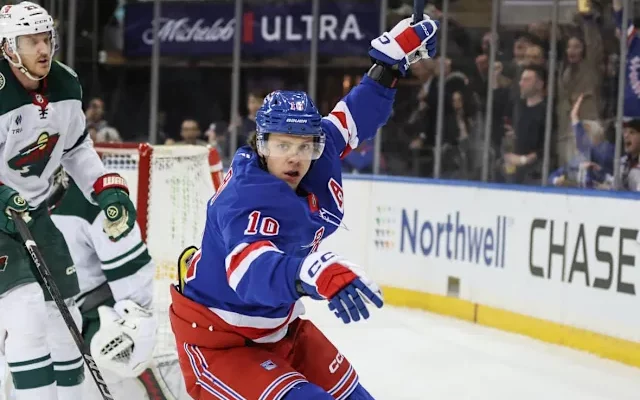Artemi Panarin has been a dazzling centerpiece of the New York Rangers ever since he arrived in Manhattan in 2019. The Russian winger, known as “The Breadman,” has consistently delivered elite offensive production, posting multiple 90-point seasons and becoming the engine of the Rangers’ power play and top line. He’s been a fan favorite, a locker room leader, and a reliable regular-season superstar. But as Panarin now approaches the final stretch of his seven-year, \$81.5 million contract—one of the largest ever handed out by the franchise—the talk around a possible extension has begun to percolate. And while re-signing such a productive player may seem like a no-brainer, the Rangers should resist the temptation to rush into a long-term extension for Panarin. There’s far more complexity at play than just his point totals.
For starters, Panarin is already 33 years old. By the time his current deal expires in the summer of 2026, he will be 34—an age where even the most skilled forwards tend to show signs of decline. While Panarin’s game isn’t overly reliant on brute strength or blazing speed—he thrives more through vision, puck control, and hockey IQ—the inevitable slowdown of reaction time and durability can’t be ignored. NHL history is filled with cautionary tales of teams that bet on aging stars only to find themselves burdened by expensive, underperforming contracts. The Rangers, who already have a number of significant financial commitments on the books, can’t afford to be another example.
The emotional pull to re-sign Panarin is understandable. He’s beloved in the locker room, adored by fans, and has been one of the most consistent point producers in the entire league since joining the Blueshirts. He’s also shown an eagerness to be part of the Rangers’ long-term plans, consistently expressing a desire to win in New York and build something lasting. Those are admirable traits, and there’s value in stability and continuity, especially for a franchise seeking its first Stanley Cup since 1994. But re-signing Panarin must be a strategic decision, not a sentimental one.
The Rangers must evaluate not just what Panarin has done but what he will likely become over the next four or five seasons. Given the NHL’s hard salary cap, every dollar counts. Locking up an aging forward to another multi-year deal at or near his current \$11.6 million average annual value could come back to haunt them, especially if younger players like Alexis Lafrenière and Kaapo Kakko finally reach their potential and command larger deals. Add in the need to keep key defenders like K’Andre Miller and Braden Schneider under contract long-term, plus the eventual extension for Igor Shesterkin, and it becomes clear that the Rangers’ cap picture is already tight—and about to get tighter.
There’s also the postseason factor to consider. For all of Panarin’s regular-season brilliance, his playoff performances have been a mixed bag at best. While he’s had some clutch moments—including the unforgettable overtime winner against the Penguins in 2022—he’s also had lengthy stretches of quiet play when the games mattered most. In the 2023 postseason, for example, Panarin was nearly invisible as the Rangers bowed out in the first round. Fair or not, superstars are judged by what they do in April, May, and June, not just October through March. If Panarin’s game continues to taper off in the playoffs, then locking him in for the long haul becomes even riskier.
One must also consider the evolution of the Rangers’ roster and identity. Over the past few seasons, there’s been a push toward becoming a younger, faster, more physical team—a shift made evident by the emergence of players like Will Cuylle, Brennan Othmann, and the steady development of Miller and Lafrenière. While Panarin still fits into the team’s core as a high-skill contributor, there may come a point where his playing style clashes with the direction the team needs to go in order to win a championship. Hockey is a ruthless sport in that regard—yesterday’s hero can quickly become today’s obstacle. The Rangers must make sure they’re not paying future dollars for past performance.
There’s also the issue of opportunity cost. Every dollar tied to a long-term Panarin extension is a dollar that can’t be used elsewhere—whether that’s reinforcing the blue line, adding bottom-six depth, or securing long-term solutions in goal and on the penalty kill. It’s not that Panarin isn’t worth the money now; it’s that he might not be worth it in three or four years. And those future cap commitments could mean the difference between a contender and a pretender in a league where windows of opportunity are razor-thin.
Of course, this doesn’t mean the Rangers should part ways with Panarin or let him walk in 2026. Far from it. The ideal scenario may be to take a wait-and-see approach. Let Panarin play out the remainder of his contract. Assess how his performance holds up as he reaches his mid-30s. Gauge how well his body absorbs the grind of an 82-game season plus playoffs. Use that information to make a smarter, more informed decision when the time comes. If Panarin continues to play at an elite level and proves he can be a difference-maker in the postseason, then a short-term extension at a reduced rate could be mutually beneficial. But committing now to a multi-year, big-money deal would be premature.
It’s also possible that Panarin himself would be open to a different kind of deal. Some veterans, especially those who love their team and city, are willing to accept shorter-term deals or lower cap hits to help the team remain competitive. If Panarin shows that kind of flexibility, then the calculus changes. A two-year deal at \$7–8 million AAV would be far more palatable than a five-year extension at north of \$10 million. But again, those conversations are best left until more information is available—not rushed based on past accolades or fear of losing a fan favorite.
In the end, the Rangers are in a crucial phase of their franchise timeline. They’ve got a strong mix of veteran talent and young potential, a Vezina-caliber goaltender in Igor Shesterkin, and a competitive Eastern Conference landscape to navigate. Every move they make over the next two years must be calculated, strategic, and future-facing. Extending Artemi Panarin, while emotionally satisfying, must not come at the expense of long-term flexibility or roster balance.
The New York Rangers have learned hard lessons in the past about aging stars and cap mismanagement. From the declining years of Brad Richards to the messy endings with Rick Nash and Henrik Lundqvist, the front office has seen firsthand how fast things can unravel when sentiment gets in the way of structure. This new era, under GM Chris Drury and head coach Peter Laviolette, must be built on discipline and foresight. That means not being afraid to say “not yet” even to someone as beloved as Artemi Panarin.
Panarin has been, and still is, a phenomenal Ranger. His impact on the ice and in the dressing room is undeniable. But the NHL isn’t about loyalty—it’s about results. If the Rangers want to end their three-decade Stanley Cup drought, they need to approach every decision, even one involving a superstar, with clarity and courage. Extending Artemi Panarin could very well be the right move in time. But for now, the smartest path is patience.



